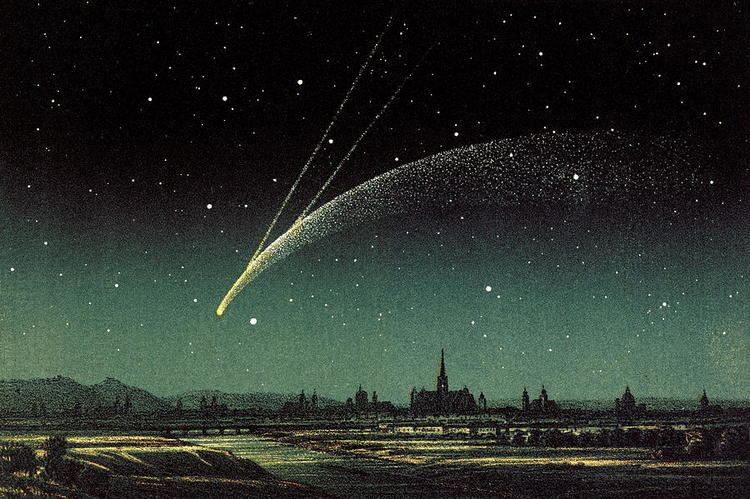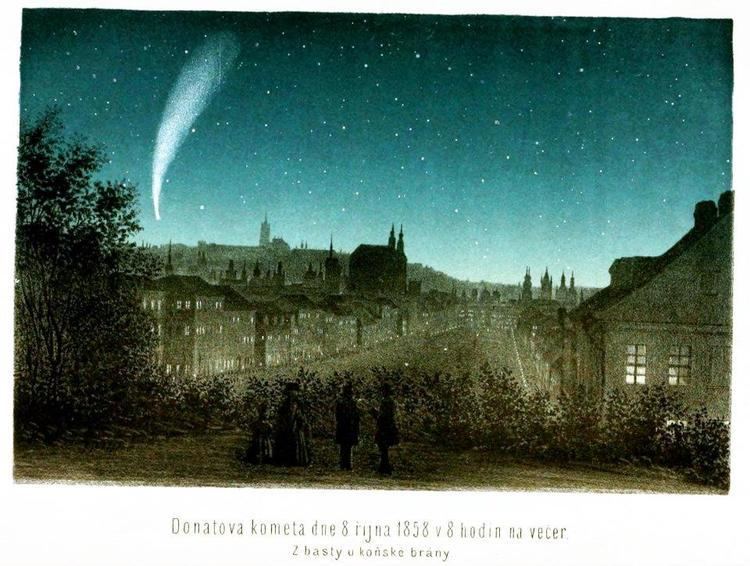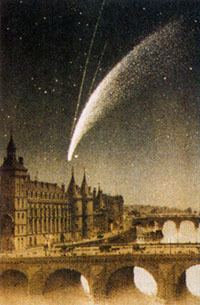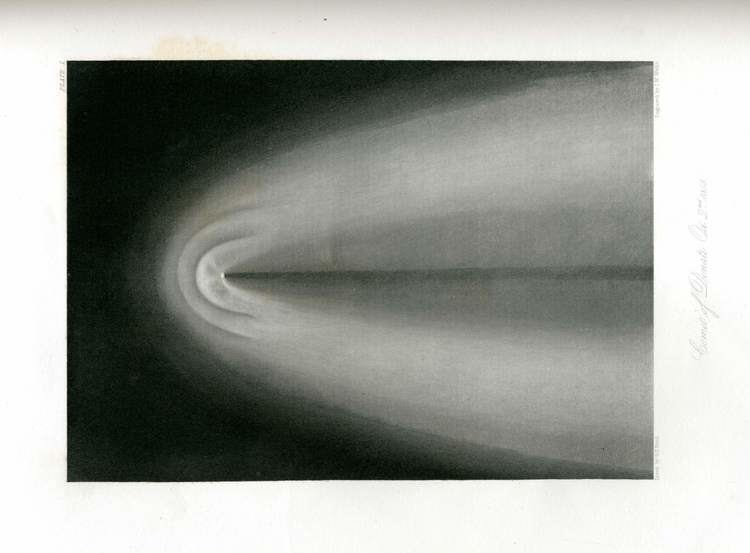Discovery date 1858 Aphelion ~289 AU Eccentricity 0.996 Discovered 2 June 1858 Inclination 116.9° Epoch 8 October 1858 | Alternativedesignations 1858 VI Semi-major axis ~147 AU Orbital period 1,953 years Last perihelion 1858 | |
 | ||
Similar C/1911 O1, Caesar's Comet, Comet Arend–Roland, C/1861 J1, Great Comet of 1811 | ||
Comet Donati, or Donati's Comet, formally designated C/1858 L1 and 1858 VI, is a long-period comet named after the Italian astronomer Giovanni Battista Donati who first observed it on June 2, 1858. After the Great Comet of 1811, it was the most brilliant comet that appeared in the 19th century. It was also the first comet to be photographed.
Contents

Discovery and observations

Donati first observed the comet on 2 June from the Florence Observatory: it was initially visible as a small nebula-like object of magnitude 7 near the "head" of Leo. By mid-August it had brightened sufficiently to be visible to the naked eye.

In September it passed into Ursa Major. For much of its apparition it occupied a unique position (among great comets) in the sky and was particularly well placed for Northern Hemisphere viewers.

It was nearest the Earth on October 10, 1858, and for much of October was a brilliant object with a long, scimitar-like dust tail and prominent gas tail. It remained a naked-eye object until November for Southern Hemisphere observers. The final observation was by William Mann, chief assistant at the Royal Observatory, Cape of Good Hope, who detected it as a faint nebulosity on March 4 1859.
During its apparition the comet was particularly closely studied by the astronomer George Phillips Bond and his father William Cranch Bond. G.P. Bond incorporated these observations and those of many other astronomers into a monograph, "An Account of the Great Comet of 1858", which remains his most important scientific work and for which he was awarded the Gold Medal of the Royal Astronomical Society, being the first American to receive the award.
Comet photographed
Donati's Comet was successfully photographed on September 27 by W. Usherwood, a portrait photographer at Walton-on-the-Hill, Surrey, using a 7 second exposure with an f/2.4 portrait lens, the first time a comet had been photographed. Usherwood's photograph, which has not survived, showed the bright region around the comet's nucleus and a part of the tail. G.P. Bond also successfully photographed the comet on September 28 at Harvard College Observatory, the first comet photograph through a telescope. He made several attempts with increasing exposure times, finally achieving a discernible image. He later wrote, "only the nucleus and a little nebulosity 15" in diameter acted on the plate in an exposure of six minutes".
Orbital calculations
The definitive orbits for the comet were calculated by Friedrich Emil von Asten and George William Hill, the latter's based on nearly 1000 positions. The comet had an orbital inclination of 116.9°. Due to its long elliptical orbit, it is estimated that Donati's Comet will not be seen passing by Earth again until the 4th millennium: Asten calculated a perihelion date of September 30.47 and an orbital period of 1880 years, and Hill suggested September 30.46 and a period of 1950 years.
In art and culture
Donati's Comet is considered to be one of the most beautiful comets observed, and was one of the brightest of the century, making a strong impression both on artists and the general public. After a prior period of hysteria on the subject of comets, especially in Paris (caused partly by incorrect calculations by John Russell Hind which suggested that one would strike the Earth in June 1857) Donati's Comet went on to be the most-observed of the century due to its excellent visibility in dark skies for Northern Hemisphere viewers, particularly in Europe, and fine weather in September and October.William Henry Smyth, an English amateur astronomer, recalled it as "one of the most beautiful objects that I have ever seen". Donati himself, a relatively obscure figure, was propelled to the status of an astronomical hero, and the comet helped cultivate a general enthusiasm for astronomy among the public.
Donati's Comet appears as a streak and star in the early evening sky of a painting by William Dyce, Pegwell Bay, Kent – a Recollection of October 5th 1858. It was featured in a number of sketches and at least one painting by William Turner of Oxford, and in a painting, "The Comet of 1858, as seen from the Heights of Dartmoor", by Samuel Palmer. The Comet at Yell'ham, a 1902 poem by Thomas Hardy, was inspired by his recollections of Donati's Comet.
Abraham Lincoln, then a candidate for a seat in the U.S. Senate, sat up on the porch of his hotel in Jonesboro, Illinois, to see "Donti's Comet" on September 14, 1858, the night before the third of his historic debates with Stephen Douglas.
The influence of the comet, particularly in visual and design terms, was such that traces of its appearance can be found in magazine and commercial illustrations, household objects, children's books and other items up until the early years of the 20th century.
